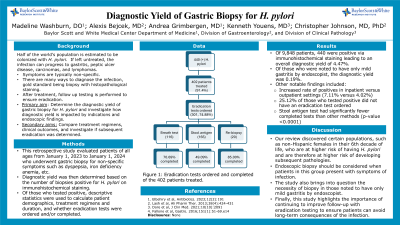Tuesday Poster Session
Category: General Endoscopy
P4117 - Diagnostic Yield of Gastric Biopsies for H. pylori
Tuesday, October 29, 2024
10:30 AM - 4:00 PM ET
Location: Exhibit Hall E

Has Audio

Madeline Washburn, DO
Baylor Scott & White Medical Center
Temple, TX
Presenting Author(s)
Madeline Washburn, DO, Alexis Bejcek, MD, Andrea Grimbergen, MD, Kenneth Youens, MD, Christopher Johnson, MD
Baylor Scott & White Medical Center, Temple, TX
Introduction: Helicobacter pylori (H. pylori) is a common infection worldwide that can cause dyspepsia, gastritis, peptic ulcer disease, and gastric cancer. The gold standard for diagnosis is endoscopic biopsy with histopathological analysis. Guidelines recommend treatment of infection be followed by testing to confirm eradication. In this study, we sought to examine the diagnostic utility of gastric biopsies and how diagnostic yield is impacted by indications and endoscopic findings. Using data from a large tertiary hospital, we determined the diagnostic yield of gastric biopsies for H. pylori, compared the frequencies of treatment regimens prescribed, and calculated the rate of post-treatment testing for eradication.
Methods: This retrospective study evaluated patients of all ages from January 1, 2023 to January 1, 2024. Patients were included who underwent gastric biopsy for unspecified dyspepsia, early satiety, nausea/vomiting, melena, history of reflux, gastritis, or other symptoms. Diagnostic yield was then determined based on the number of patients positive for H. pylori on immunohistochemical (IHC) staining. Of those who tested positive, descriptive statistics were used to calculate patient demographics, treatment regimens and duration, and whether eradication tests were ordered and/or completed.
Results: Our sample included 9,848 patients who underwent endoscopic biopsy to test for H. pylori. Of those, 440 were positive via IHC staining leading to an overall diagnostic yield of 4.47%. Of those who were noted to have only mild gastritis by endoscopist, the diagnostic yield was 0.19%. Other notable findings included an increased rate of positives in inpatient versus outpatient settings (7.11% versus 4.02%), 25.12% of those who tested positive did not have an eradication test ordered by their provider, and, when ordered, the stool antigen test had significantly fewer completed tests than other methods.
Discussion: Our review discovered certain populations, such as non-Hispanic females in their 6th decade of life, who are at higher risk of having H. pylori and are therefore at higher risk of developing subsequent pathologies. Endoscopic biopsy should be considered when they present with symptoms of infection. The study also brings into question the necessity of biopsy in those noted to have only mild gastritis by endoscopist. Finally, it highlights the importance of continuing to improve follow-up with eradication testing to ensure our patients can avoid long-term consequences of the infection.
Note: The table for this abstract can be viewed in the ePoster Gallery section of the ACG 2024 ePoster Site or in The American Journal of Gastroenterology's abstract supplement issue, both of which will be available starting October 27, 2024.
Disclosures:
Madeline Washburn, DO, Alexis Bejcek, MD, Andrea Grimbergen, MD, Kenneth Youens, MD, Christopher Johnson, MD. P4117 - Diagnostic Yield of Gastric Biopsies for </i>H. pylori</i>, ACG 2024 Annual Scientific Meeting Abstracts. Philadelphia, PA: American College of Gastroenterology.
Baylor Scott & White Medical Center, Temple, TX
Introduction: Helicobacter pylori (H. pylori) is a common infection worldwide that can cause dyspepsia, gastritis, peptic ulcer disease, and gastric cancer. The gold standard for diagnosis is endoscopic biopsy with histopathological analysis. Guidelines recommend treatment of infection be followed by testing to confirm eradication. In this study, we sought to examine the diagnostic utility of gastric biopsies and how diagnostic yield is impacted by indications and endoscopic findings. Using data from a large tertiary hospital, we determined the diagnostic yield of gastric biopsies for H. pylori, compared the frequencies of treatment regimens prescribed, and calculated the rate of post-treatment testing for eradication.
Methods: This retrospective study evaluated patients of all ages from January 1, 2023 to January 1, 2024. Patients were included who underwent gastric biopsy for unspecified dyspepsia, early satiety, nausea/vomiting, melena, history of reflux, gastritis, or other symptoms. Diagnostic yield was then determined based on the number of patients positive for H. pylori on immunohistochemical (IHC) staining. Of those who tested positive, descriptive statistics were used to calculate patient demographics, treatment regimens and duration, and whether eradication tests were ordered and/or completed.
Results: Our sample included 9,848 patients who underwent endoscopic biopsy to test for H. pylori. Of those, 440 were positive via IHC staining leading to an overall diagnostic yield of 4.47%. Of those who were noted to have only mild gastritis by endoscopist, the diagnostic yield was 0.19%. Other notable findings included an increased rate of positives in inpatient versus outpatient settings (7.11% versus 4.02%), 25.12% of those who tested positive did not have an eradication test ordered by their provider, and, when ordered, the stool antigen test had significantly fewer completed tests than other methods.
Discussion: Our review discovered certain populations, such as non-Hispanic females in their 6th decade of life, who are at higher risk of having H. pylori and are therefore at higher risk of developing subsequent pathologies. Endoscopic biopsy should be considered when they present with symptoms of infection. The study also brings into question the necessity of biopsy in those noted to have only mild gastritis by endoscopist. Finally, it highlights the importance of continuing to improve follow-up with eradication testing to ensure our patients can avoid long-term consequences of the infection.
Note: The table for this abstract can be viewed in the ePoster Gallery section of the ACG 2024 ePoster Site or in The American Journal of Gastroenterology's abstract supplement issue, both of which will be available starting October 27, 2024.
Disclosures:
Madeline Washburn indicated no relevant financial relationships.
Alexis Bejcek indicated no relevant financial relationships.
Andrea Grimbergen indicated no relevant financial relationships.
Kenneth Youens indicated no relevant financial relationships.
Christopher Johnson indicated no relevant financial relationships.
Madeline Washburn, DO, Alexis Bejcek, MD, Andrea Grimbergen, MD, Kenneth Youens, MD, Christopher Johnson, MD. P4117 - Diagnostic Yield of Gastric Biopsies for </i>H. pylori</i>, ACG 2024 Annual Scientific Meeting Abstracts. Philadelphia, PA: American College of Gastroenterology.
